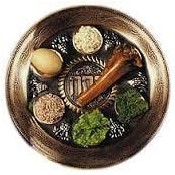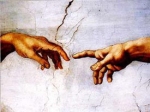Verse: Deuteronomy 6:20 When your son asks you in time to come, What is the meaning of the
testimonies and statutes and precepts which the Lord our God has commanded you? AMP
Read pp. 30-33 Messiah in the Feasts of Passover by Sam Nadler

One of the major elements of the traditional Passover celebrations is the Seder plate. Several
ceremonial foods are placed on a single plate and some are eaten as the Haggadah is read through the
meal. “Haggadah” means “telling”. It is the text that sets forth the order of the Passover Seder. Reading
the Haggadah at the Seder table is a fulfillment of the Scriptural commandment to each Jew to "tell your
son" of Israel’s liberation from slavery in Egypt as described in the Book of Exodus in the Torah ("And
thou shalt tell thy son in that day, saying: It is because of that which the LORD did for me when I came
forth out of Egypt." Exodus 13:8).
The retelling of the Passover story involves more than just words, it includes the senses of taste, smell,
and sight. We learn and remember as we eat. What a delightful lesson we have to eat together as we
keep the feast. Some of the Seder plate traditions make more sense than others, but they are all
described here so we can understand just what they are.
The Seder plate can be ornately painted and it is often a treasured item
in the Jewish home, or it can be as simple as a paper plate sometimes
decorated with crayons or markers by children. The elements and their
representation are the same no matter how plain or fancy the plate,
Shank Bone (Zeroa) – The shank bone is the leg bone of a lamb or a
chicken. The emphasis is less on the animal and more on the reminder of
the original sacrifice of the Lamb and that it should be roasted whole
with none of its bones broken (Exodus 12:46, John 19:33-37).
Egg (Beitzah) – The egg is perhaps the most confusing of elements on the plate. Jewish tradition
identified the roasted egg with the “chagigah” offering of the Passover feast during Temple times. The
chagigah offering was a special offering specified for each of the three required assemblies (Passover,
Feast of Weeks, and Feast of Tabernacles). A chagigah offering was in the category of a “peace” offering.
A peace offering was shared with YHWH, the priest, and the person presenting the offering. At Passover,
the chagigah was the lamb without blemish that was used for the memorial meal. It was taken to the
Temple for inspection a few days before the feast and roasted and eaten by families on Passover.
Usually the egg is boiled and then roasted to darken its color and resemble the roasted color of the
lamb. Eggs are also associated with the mourning for the destruction of the Temple in Jerusalem. Boiled
eggs are a traditional food served at funerals in Jewish culture, and so the connection to the “death” of
the Temple service. Boiled eggs are served at the beginning of the main meal. The roasted egg remains
on the Seder plate and is not usually eaten.
For us as believers in the sacrifice of our Messiah, Jesus, we have come to know the Temple of God is in
the hearts of men and there is no longer need for the ministry of the Temple in Jerusalem, therefore
there is also no need for mourning its loss (2 Corinthians 6:16.)
Ephesians 2:18-22
For through him we both have access in one Spirit to the Father. So then you are no longer
strangers and aliens, but you are fellow citizens with the saints and members of the household
of God, built on the foundation of the apostles and prophets, Christ Jesus himself being the
cornerstone, in whom the whole structure, being joined together, grows into a holy temple in
the Lord. In him you also are being built together into a dwelling place for God by the Spirit.
ESV
Bitter Herbs (maror) – The bitter herbs are usually horseradish, either ground or whole roots. Romaine
lettuce is also used because it turns bitter as it gets older. The horseradish is eaten several times
throughout the meal and it is used as a reminder of the bitterness of the oppression of the slaves in
Israel. Just as the bitterness of the horseradish brings tears to our eyes, we remind ourselves of the
bitterness of their bondage. For believers in Messiah we can recall the bitterness of our bondage to sin
before we experienced freedom from its power.
Vegetables (karpas) – Karpas can include any kind of vegetable either cooked or raw including parsley,
celery, carrots, or other greens. Karpas are dipped in salt water and eaten to remind us of the tears that
were shed during the bondage of slavery.
Sweet Fruit Mixture (haroset) – Haroset is a sweet mixture of chopped apples, honey, nuts and other
dried fruits. There are many recipes, but the mixture is supposed to look red/brownish and resemble the
consistency of the clay used to make bricks for their Egyptian overlords. It is eaten with matzah
(unleavened bread) and maror at different times during the meal.





Terms & Conditions
Subscribe
Report
My comments